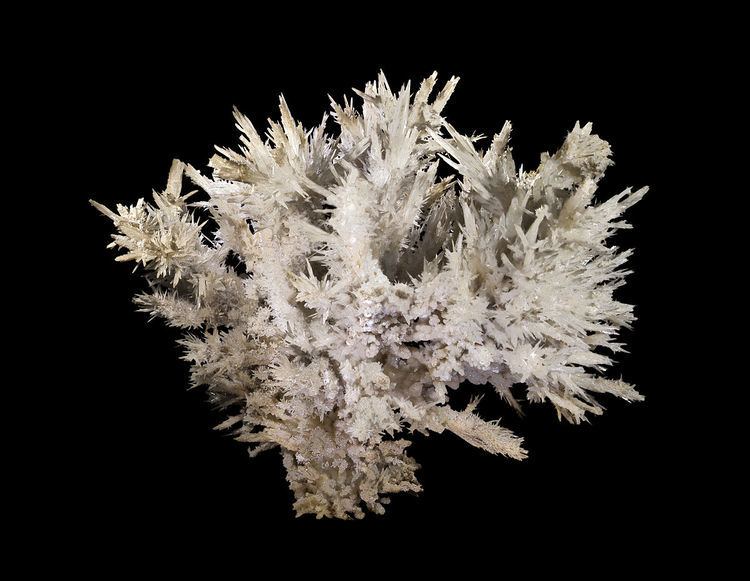Category Carbonate mineral Strunz classification 5.AB.15 Space group Pmcn | Formula(repeating unit) CaCO3 | |
 | ||
Crystal class Dipyramidal (mmm)H-M symbol: (2/m 2/m 2/m) | ||
Aragonite is a carbonate mineral, one of the two most common, naturally occurring, crystal forms of calcium carbonate, CaCO3 (the other form being the mineral calcite). It is formed by biological and physical processes, including precipitation from marine and freshwater environments.
Contents
Aragonite's crystal lattice differs from that of calcite, resulting in a different crystal shape, an orthorhombic crystal system with acicular crystal. Repeated twinning results in pseudo-hexagonal forms. Aragonite may be columnar or fibrous, occasionally in branching stalactitic forms called flos-ferri ("flowers of iron") from their association with the ores at the Carinthian iron mines.
Occurrence
The type location for aragonite is Molina de Aragón (Guadalajara, Spain), 25 km from Aragon for which it was named in 1797. An aragonite cave, the Ochtinská Aragonite Cave, is situated in Slovakia. In the US, aragonite in the form of stalactites and "cave flowers" (anthodite) is known from Carlsbad Caverns and other caves. Massive deposits of oolitic aragonite sand are found on the seabed in the Bahamas.
Aragonite is the high pressure polymorph of calcium carbonate. As such, it occurs in high pressure metamorphic rocks such as those formed at subduction zones.
Aragonite forms naturally in almost all mollusk shells, and as the calcareous endoskeleton of warm- and cold-water corals (Scleractinia). Several serpulids have aragonitic tubes. Because the mineral deposition in mollusk shells is strongly biologically controlled, some crystal forms are distinctively different from those of inorganic aragonite. In some mollusks, the entire shell is aragonite; in others, aragonite forms only discrete parts of a bimineralic shell (aragonite plus calcite). The nacreous layer of the aragonite fossil shells of some extinct ammonites forms an iridescent material called ammolite.
Aragonite also forms in the ocean and in caves as inorganic precipitates called marine cements and speleothems, respectively. Aragonite is not uncommon in serpentinites where high Mg in pore solutions apparently inhibits calcite growth and promotes aragonite precipitation.
Aragonite is metastable at the low pressures near the Earth's surface and is thus commonly replaced by calcite in fossils. Aragonite older than the Carboniferous is essentially unknown. It can also be synthesized by adding a calcium chloride solution to a sodium carbonate solution at temperatures above 60 °C (140 °F) or in water-ethanol mixtures at ambient temperatures.
Physical properties
Aragonite is thermodynamically unstable at standard temperature and pressure, and tends to alter to calcite on scales of 107 to 108 years. The mineral vaterite, also known as μ-CaCO3, is another phase of calcium carbonate that is metastable at ambient conditions typical of Earth's surface, and decomposes even more readily than aragonite.
Uses
In aquaria, aragonite is considered essential for the replication of reef conditions. Aragonite provides the materials necessary for much sea life and also keeps the pH of the water close to its natural level, to prevent the dissolution of biogenic calcium carbonate.
Aragonite has been successfully tested for the removal of pollutants like zinc, cobalt and lead from contaminated wastewaters.
